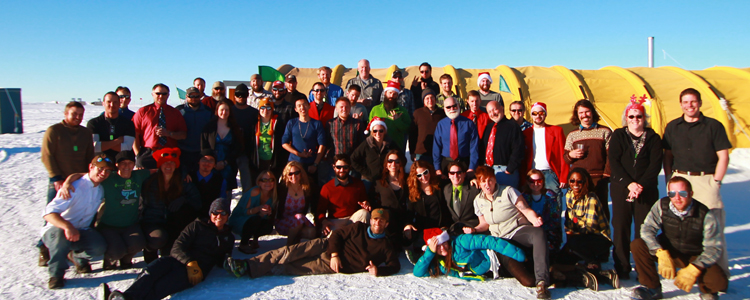News
Field and CPL Updates
2012-2013 Antarctica

Great news. The drill team has completed all the coring objectives for the season. Considering that making a deviation without blocking access to the lower part of the borehole had never been done before, this is a major achievement. There were many technical issues that had to be overcome and the length of time available to do the work was small, but the field crew overcame the problems and completed the effort. This was a team effort, with great support from the camp staff, and constant attention by the SCO crew to make sure the cores were archived correctly.
We had a problem when we tried to clean the chips from the bottom of the main hole and came very close to sticking the replicate coring drill due to ice refreezing on the drill head. We think the chips behaved like toothpaste when the drill tried to core, and oozed around the head rather than cutting like ice would. The chips then refroze on the cold drill. Tension on break was about 10,000 N which is within 2,000 N of the highest core break seen, even though there was no core to break, just chips. The drill was then reconfigured with the DISC coring head (which is a larger diameter head than the replicate coring head) used for drilling the main borehole to see if that configuration yielded better success. However, we were only able to get to a depth of 2498 meters before having to ream. This proceeded at a rate of 20 mm/sec. Given the remaining depth to the chip pack, the volume of chips that would be produced by this process, and the time available it became clear that we would not reach the bottom before the end of the season. The difficult decision was then made to call it a season and leave about 12 meters of chips at the bottom of the borehole; touch-off was at 3393 meters. While we are disappointed not to be able to leave a pristine hole to 3405 meters, the risks involved (a stuck drill) outweighed the scientific benefits of a chip-free hole to 3405 meters.
This brings the core collection phase of the WAIS Divide project to a close. It has taken eight field seasons to prepare for drilling, collect the main core, and collect replicate cores from five intervals. It will take another two field seasons to complete the repeat borehole logging and remove the camp and drill arch. It has been a wonderful journey and we thank everyone that contributed in any way to the effort.
The richness of datasets that are coming out of the labs is exceeding our expectations. The records have much greater time resolution and analytical precision than any other record, and contain many new measurements that have not been made on other deep cores. Although the excitement of the fieldwork is behind us, it is being replaced with a different kind of excitement as the lab results become available and we examine the Earth system with unprecedented detail. The integrated interpretations we are starting to develop will be our contribution to helping predict the future of our climate and the West Antarctic Ice Sheet.
To watch an EXCELLENT video that explains the replicate coring process, and that also contains actual borehole video from the first deviation drilled this season, visit:
http://www.youtube.com/user/USIceDrillingVideos
Our thanks to Chris Gibson and everyone at IDDO for putting together the Replicate Ice Coring System video so quickly.
Krissy and Don's weekly reports are attached. An image of the field crew and camp staff is also attached.

